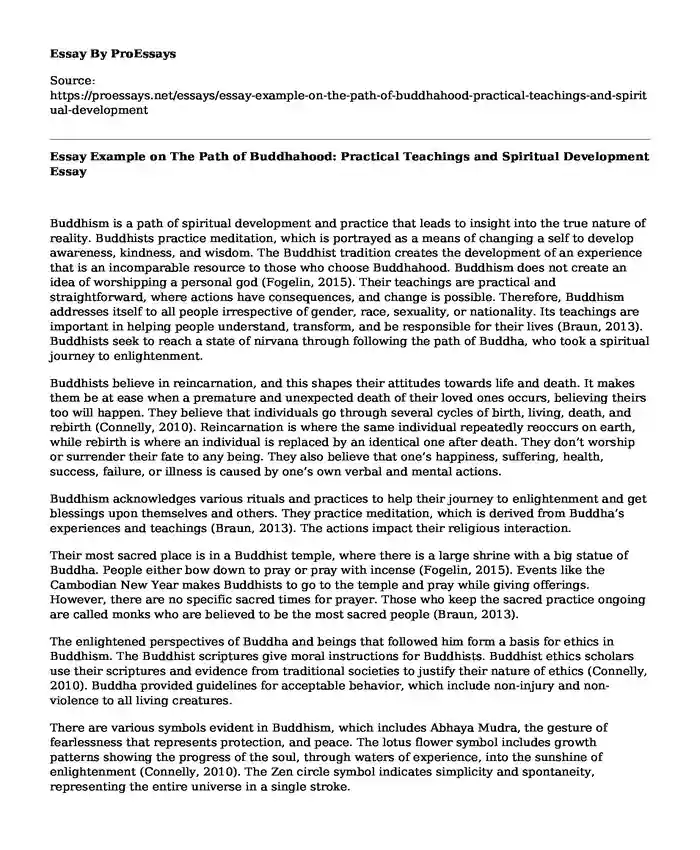Buddhism is a path of spiritual development and practice that leads to insight into the true nature of reality. Buddhists practice meditation, which is portrayed as a means of changing a self to develop awareness, kindness, and wisdom. The Buddhist tradition creates the development of an experience that is an incomparable resource to those who choose Buddhahood. Buddhism does not create an idea of worshipping a personal god (Fogelin, 2015). Their teachings are practical and straightforward, where actions have consequences, and change is possible. Therefore, Buddhism addresses itself to all people irrespective of gender, race, sexuality, or nationality. Its teachings are important in helping people understand, transform, and be responsible for their lives (Braun, 2013). Buddhists seek to reach a state of nirvana through following the path of Buddha, who took a spiritual journey to enlightenment.
Buddhists believe in reincarnation, and this shapes their attitudes towards life and death. It makes them be at ease when a premature and unexpected death of their loved ones occurs, believing theirs too will happen. They believe that individuals go through several cycles of birth, living, death, and rebirth (Connelly, 2010). Reincarnation is where the same individual repeatedly reoccurs on earth, while rebirth is where an individual is replaced by an identical one after death. They don’t worship or surrender their fate to any being. They also believe that one’s happiness, suffering, health, success, failure, or illness is caused by one’s own verbal and mental actions.
Buddhism acknowledges various rituals and practices to help their journey to enlightenment and get blessings upon themselves and others. They practice meditation, which is derived from Buddha’s experiences and teachings (Braun, 2013). The actions impact their religious interaction.
Their most sacred place is in a Buddhist temple, where there is a large shrine with a big statue of Buddha. People either bow down to pray or pray with incense (Fogelin, 2015). Events like the Cambodian New Year makes Buddhists to go to the temple and pray while giving offerings. However, there are no specific sacred times for prayer. Those who keep the sacred practice ongoing are called monks who are believed to be the most sacred people (Braun, 2013).
The enlightened perspectives of Buddha and beings that followed him form a basis for ethics in Buddhism. The Buddhist scriptures give moral instructions for Buddhists. Buddhist ethics scholars use their scriptures and evidence from traditional societies to justify their nature of ethics (Connelly, 2010). Buddha provided guidelines for acceptable behavior, which include non-injury and non-violence to all living creatures.
There are various symbols evident in Buddhism, which includes Abhaya Mudra, the gesture of fearlessness that represents protection, and peace. The lotus flower symbol includes growth patterns showing the progress of the soul, through waters of experience, into the sunshine of enlightenment (Connelly, 2010). The Zen circle symbol indicates simplicity and spontaneity, representing the entire universe in a single stroke.
Conclusion
In conclusion, various societies are multi-ethnic, multi-cultural, and multi-religious, which make religious freedom and mutual respect an integral part of people who share culture. There is more to Buddhism than just what meets the eye. Buddhists have various beliefs and practices which they derive from Buddha’s teachings. Their religious beliefs, ethics, rituals, sacred symbols, and social structure makeup and help us understand who Buddhists are in contemporary society.
References
Braun, E. (2013). The birth of insight: Meditation, Modern Buddhism, and the Burmese monk Ledi Sayadaw. University of Chicago Press.
Connelly, L. (2010). Virtual Buddhism: An analysis of aesthetics about religious practice within Second Life. Online-Heidelberg Journal of Religions on the Internet. https://archiv.ub.uni-heidelberg.de/volltextserver/11295/1/02.pdf
Fogelin, L. (2015). An archaeological history of Indian Buddhism. Oxford Handbooks.
Cite this page
Essay Example on The Path of Buddhahood: Practical Teachings and Spiritual Development. (2023, Sep 20). Retrieved from https://proessays.net/essays/essay-example-on-the-path-of-buddhahood-practical-teachings-and-spiritual-development
If you are the original author of this essay and no longer wish to have it published on the ProEssays website, please click below to request its removal:
- Faith Integration Paper: Wealth Accumulation
- From Jesus to Christ Essay
- Essay Sample on Christian Hymnody: Expressing Worship & Praise to God
- A Critical Assessment of Etienne Gilson's "God and Philosophy"
- Essay Example on Christ's Physical Resurrection: Scriptural Basis of Christian Faith
- Essay Example on God is One: Dialogue with Other Religions and Controversies
- Essay Sample on My Theology Journey: From Ignorance to Enlightenment







